
Capitol Records of Canada - the corporate history timeline
Provided by Steve Clifford and updated by Serge Pelletier with help of the excellent book by Nicholas Jennings: FIFTY YEARS OF MUSIC - THE STORY OF EMI MUSIC CANADA)
1942
The Capitol Records Company was founded in the USA by songwriter Johnny Mercer. On July 1st, the company issued 9 different 78 RPMs (from # 101 to 109 - including one of Mercer's records - # 103).
On this first ever Capitol label, the silver logo on the black label showed the building structure under the word CAPITOL. The regular use of the "structure label" was dropped after the first 50 or so records (but was used from time to time for around another 50. Numbers 186 and 187 for example, both have the "structure label"). The label then featured the classic dome logo we know today.
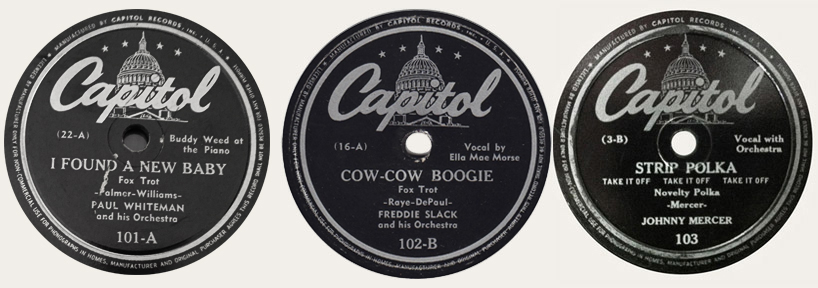
June 1947
Capitol USA realized the great potential of the Canadian market, that customers would have the opportunity to buy domestic products instead of paying expensive fees to import their favorite records. In 1947, Capitol incorporated the Capitol Canada company and hired Ken Kerr, a former Sparton Records sales manager from London, Ontario to run Canadian operations for Capitol, therefore being then, the only Canadian employee of the company.
This did not last long however, as the operation was shut down soon after because of Government restrictions on foreign investments. The project was too good to simply accept its demise that easily. So Ken Kerr and two other associates had the idea to start their own record company, and that way they MIGHT just inherit the contract to press records for Capitol, here in Canada. They succesfully raised enough money through different investors and found a commercial property in London, Ontario near the railroad tracks, making it easy to ship records once they were pressed. They named the company Regal Records. (not to be confused with the 1914 British label of the same name).
1947
Until Regal was up and running, Capitol Canada remained inactive, but Capitol USA still wanted to put their hand on the Canadian market share, so for the next year and a half or so, they had their records pressed by Musicana, the company where Ken Kerr's associate (Scotty McLachlan) was working until it closed down, leading the way to Regal Records.
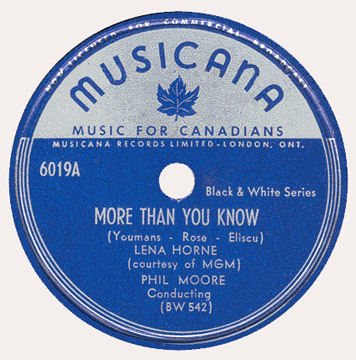
1948
One quick year later, in August 1948, with only 12 employees, Regal Records started to press 10 inch 78 rpm records. The first Regal pressing being # 101 "You Call Everybody Darling / Linger Awhile" by Al Trace actually sold quite enough to gain the attention of other record companies. Things went well for Regal and they soon began pressing records for USA labels like REGENT and soon after, in June 1949, they signed the well deserved 5 year contract to press Capitol Records in Canada.
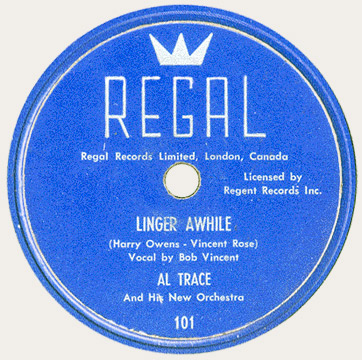
1949
Lockwood Miller (a businessman from London, Ontario - originally from L.A.) buys all shares of Regal Records and in June of that year, Capitol of Canada issues its very first record on the now classic purple label (78 rpm). The label had changed from black to purple by the time Canada issued their very first first record 78-101.
For more information on Capitol's early discography, please visit our Early Capitol Records page.
Gordon Macrae
24 hour of Sunshine / Wedding of Lili Marlene
Capitol 78 -101.
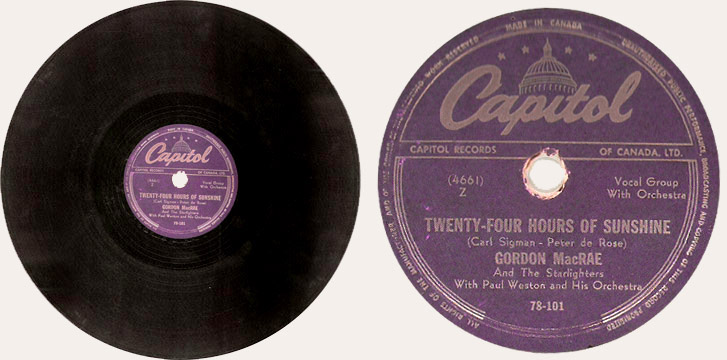
1950
Capitol of Canada issued its first Canadian artist recording, thus beginning a long tradition in supporting Canadian talent.
Jack Kingston
Yodeling Cowboy
Capitol C-654.
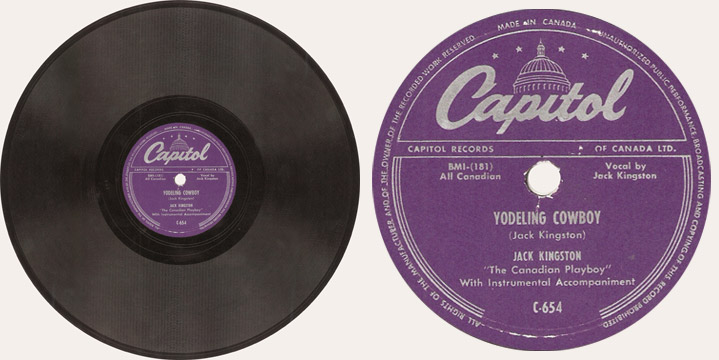
1950
As soon as the early 1950s, Capitol of Canada started pressing different formats, adding 33 RPM LPs and 45 RPM discs to their catalog.
July 1,1954
Capitol USA terminates it’s relationship with Lockwood Miller and forms «Capitol Record Distributors of Canada Limited» with head office in Toronto, branch office in Montreal and three independent distributors in the west.
Capitol began contracting to RCA plant in Smith Falls, Ontario.
1956
Capitol moves into 2nd floor offices of the Coka Cola building at 635 Queen St. East, Toronto, where they were sandwiched between the 1st and 3rd floors of Coke offices. Capitol Record Club of Canada formed shortly thereafter on Broadview Avenue, Toronto (ceased operations in 1970).
1956
EMI (UK) purchases Capitol Record USA and thereby acquires the Canadian operation. Initially this had little effect on Capitol of Canada since the «Yanks» ran the show anyway.
1958
The company name change from «Capitol Record Distributors of Canada» to «Capitol Records of Canada Ltd.» (they had to wait until Miller’s rights to the name had expired).
1957
Paul White joins Capitol as a shipper

A very rare release sheet for November 17th., 1958. It shows the very first release by Cliff Richard And The Drifters. Move It was available on both 78 RPM and 45 RPM formats. Also you can see that Capitol at this time is selling "stereophonic albums", including The Music Man soundtrack which featured the song Til There Was You, a later favourite of Paul McCartney. These release sheets were sent out to the record shops across Canada.
1959
Capitol celebrates 10 years, and Angel and Pathé Marconi formed. Around the same period, Coke leaves the building and Capitol take over all three floors; this is also when the Record club moves in.
1960
Paul White moves to Order Desk and then on to Promotion and then establishes 6000 series, the basis of what became the A&R Department. The first Capitol of Canada LP was T 6000 «Freddy Gardner: The Unforgettable

Late 1962
Geoffrey F. Racine becomes the new President (replacing Harold Smith) and Capitol begins issuing Pop records from Britain. Even after the poor sales of Love Me Do, Capitol continued issuing Beatles singles despite and their tenacity payed off as they began charting in London, Vancouver, Winnipeg, Kingston, Hamilton, and by November 1963,Toronto
Other British Invasion groups for who Capitol of Canada paved the way in North america included Dave Clark Five, the Yardbirds, Gerry and the Pacemakers, Freddie and the Dreamers, the Swinging Blue Jeans, Billy J. Kramer and the Dakotas, the Hollies and Manfred Mann.
All were charting in Canada (and all were passed on by Capitol A&R in LA). The Animals and Herman’s Hermits were also initially issued by Capitol of Canada.
1966
Capitol bought 4 acres in Mississauga (financed by Beatles bucks!)
September 15, 1966
CAPITOL RECORDS OF CANADA was re-incorporated as CAPITOL RECORDS (CANADA) LTD. - DISQUES CAPITOL (CANADA). This means that starting soon after, all labels were to be marked as such, or what we call WITH BRACKETS on either LPs or singles

1967
150 Employees move to 3109 American Drive, Mississauga, Ontario
1970
Capitol started a new tape plant (mainly 8-tracks) and moved this operation to Mississauga in 1971.
1974
The legal comapny name change to «Capitol Records-EMI of Canada»

May 1975
Capitol announce plans to build record pressing plant
June 7, 1976
Capitol pressing plant opens in Mississauga (on land adjacent to their American Drive offices) starting with 45 RPM singles pressings. (closed in 1984).
July 1976
The Canadian A&R department merges with the US
June 15, 1977
The Capitol pressing plant is fully up and running in Mississauga with LPs, 45s and tapes. A promotional record (SPRO 9) was issued to commemorate the official opening of the plant.
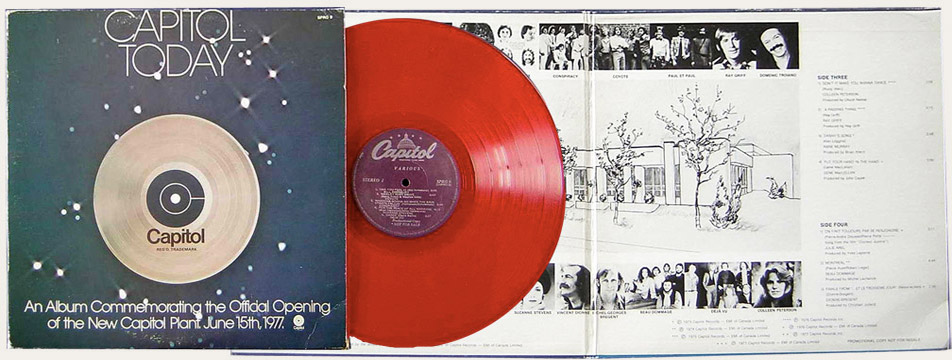
1978
Paul White leaves A&R and is replaced by Deane Cameron
1982
Capitol develops SDR (Super Dynamic Range) tape technology which US adopts and renames to XDR (Expanded Dynamic Range).

1984
Thorn merges with EMI (leading to HMV stores coming to Canada)
January 1984
Capitol began pressing and issuing CDs
1985
The Canadian A&R department becomes more independent (although not entirely).
March 1988
Capitol of Canada closes down its retail outlets (Mister Sound).
1999
EMI Music Canada celebrated its fiftieth anniversary.
Mid 2000s
After the internet download / Napster tidal wave on the music industry, ways of finding, listening to, producing and obtaining music was suddenly very different and the business model drastically changed within a few short months. Artists and buyers suddenly had more power and autonomy, and many companies understood this new paradigm and quickly reacted to adapt their business model to the new market. They had no choice but to embrace digital distribution as the new avenue in music sales, associating themselves with digital distribution companies like iTunes or streaming companies like Rhapsody.
Other companies (like EMI), on the other hand, being either skeptical that these changes were becoming inevitable business models, or thinking they would survive just another trend on the roller coaster ride of the industry, remained a little too cautious towards digital distribution. Unfortunately, this turned out to be a costful choice as many big names from their roster did not see the future of their music in the same way and fearing the company's position, decided to leave EMI as soon as their contract was over in order to have a say over production and distribution of their music.
This was the case with Paul McCartney and Radiohead for example. Wanting total control over creative and distribution rights, in October 2007, Radiohead issued their next album independently as a "give what you want for our album" digital download. As it turns out, a few chose to give 0$, but most people gave the classic 9.99$ that we were used to find on iTunes, making this album reportedly their most profitable by far, therefore making this a chocking example of the unsuspected power of independant releases to the rest of the music industry. So much that music empires such as EMI almost imploded soon after.
2007
The private equity firm TERRA FIRMA bought EMI for 4.2 billion pounds in order to save them from bancrupty.
November 2011
After buying EMI in 2007, "Terra Firma" could not make payments and had to hand over EMI to Citigroup. In November 2011, EMI was sold for a total of 4 billion US $ (1.9$ Bn to Universal for the music division, and 2$ Bn to Sony ATV for the music publishing division).
Taken from the Encyclopedia of Music in Canada - Second Edition. Published by
the University of Toronto Press, 1992
(ISBN 0-8020-2881-0).
Quoted under the entry:
Capitol Records - EMI of Canada Limited/ Disques Capitol - EMI du Canada Limitée (Capitol Records of Canada Ltd 1947-54, Capitol Record Distributors of Canada Ltd 1954-8, Capitol Records of Canada Ltd again 1958-74).
«Company established in Canada in 1954 by the US parent firm, Capitol Records, which had been founded in 1942 by the songwriters Buddy DeSylva, Johnny Mercer, and Glenn Wallachs. Prior to 1954 Capitol Records were pressed and distributed in Canada 1946-7 by Musicana Records.
«In 1947 an associate firm, Capitol Records of Canada, Ltd, was set up in London. It remained inactive, however, until it was purchased by W. Lockwood Miller in 1949. Capitol dates it’s history from this time. In 1954 the Miller company was replaced by the parent firm with Capitol Record Distributors of Canada, Ltd. The US company itself was taken over by Electrical and Musical Industries (EMI) of Great Britain in 1956, and the Canadian operation was renamed, in turn, Capitol Records of Canada Ltd in 1958 and Capitol Records - EMI of Canada Ltd in 1974. Head offices were established in Toronto in 1954, and branch offices opened in Montreal and , eventually, Calgary and Vancouver...»
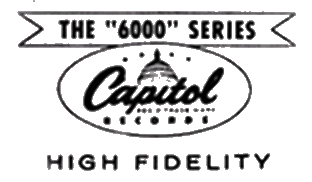
Copyright © 1999 - 2018
Capitol6000 & Hemmingsen Publishing
Piers A. Hemmingsen & Serge Pelletier. All Rights Reserved.